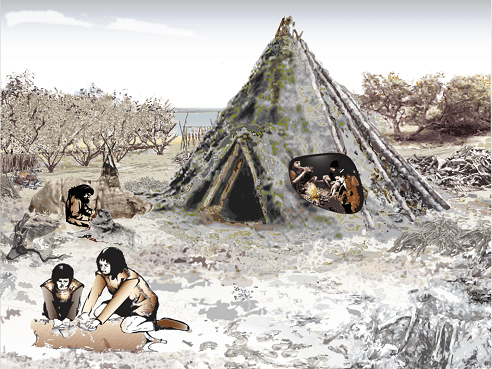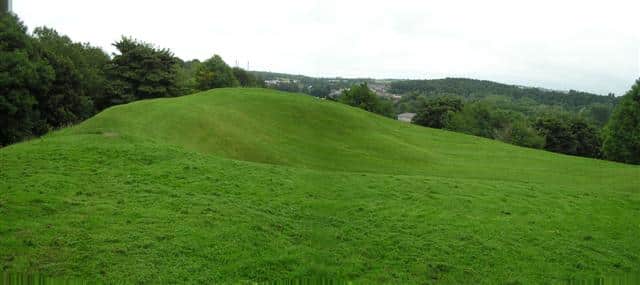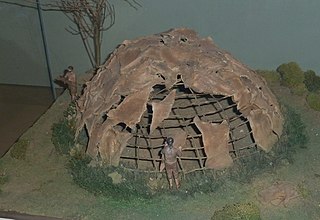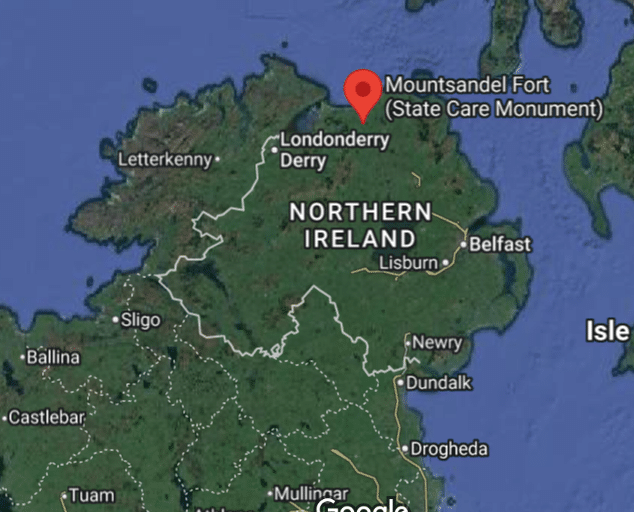Ireland’s Ancient Beginnings
Tracing our family history has become one of the most popular pastimes across the world. This is particularly true for the many millions (estimates vary between 50-80million) of people claiming Irish ancestry. Meticulous detective work reveals all sorts of fascinating personal histories tracing back generations to their roots. But what about 400 generations? For that’s how many separate us from our ancient ancestors at the little-known site of Mount Sandel in Northern Ireland.
The Settlement of Mount Sandel
If you were to visit Mount Sandel today you could be forgiven for wondering what the fuss is all about. Situated on the edge of the River Bann, the settlement looms 30m above the waters on the edge of a beautiful woodland. But a closer look will show just how strategic a location it would have been to our ancestors.
Overland travel in ancient Ireland was dangerous and challenging due to dense woodlands and an abundance of predators. Rivers and coasts offered the safest and fastest way to traverse the island. Evidence of water transport has been well-established dating back almost as long as humans themselves. Even after humans had developed an agrarian society, the abundance of salmon and eels would have been invaluable. Situated on an easily defensive escarpment and overlooking a key fording point in the river, makes this a clear choice for any early human settlement.
In fact, evidence of human activity dates not only back to the ancient Mesolithic, but also throughout Irish history with many other later buildings and artifacts discovered. But if you were to visit this site today, it is hard to imagine what secrets lie buried beneath the verdant, grassy hilltop. For that we must turn to my favourite subject, to archaeology.

Archaeological Significance
Finding evidence of the earliest human activity in Ireland has occupied archaeologists for almost as long as the discipline has existed. But the Mesolithic site of Mount Sandel presents one of the earliest yet most complete discoveries in this search. From it we can develop a picture of the diet, lifestyle, and living conditions these ancient ancestors enjoyed. It gives us a picture of what life involved and what our forebears might have been like. Similar to when our family histories reveal some exciting secret, these finds provide us with rare insights into these ancient Irish peoples.
In the 1970s, archaeologist Peter Woodman conducted a series of excavations which revealed surprising evidence of human habitation. It was surprising because it dated the site to a staggering 8000BC – the time of hunter-gatherers.1

Archaeological Evidence
The settlement consisted of a series of wigwam-shaped huts, like sliced eggs, grouped together. Each ranged in size between 3-6m in diameter. Archaeologists estimate this could have supported anywhere between 3 and 15 people.2 The huts themselves were built using a structure of sapling poles overlaid with hide and turf. Inside, a small firepit sat at the centre.
Within these pits were found the remains of fish (mostly salmon and eel), birds, wild pig, hare, and even a dog bone. You can imagine these early hunters using traps and spears to catch the migrating salmon or trapping eels. Able foragers, there was evidence of hazelnuts, water-lily and apple seeds, providing a relatively varied and full diet for this period of history. These were a healthy and likely happy people.
They were also able builders and craftsmen. Besides the structures themselves (which only show us a partial impression of what they built), over 1100 flint tools were discovered at the site. Varying in shape and size, these picks, axes, and hammers, show just how developed and skilled these craftsmen were. But the sheer number and range begs a wider question of where they originated from.

Ancient culture and society
Significant research has gone into the provenance of such artifacts with much speculation. At the very least, it is likely there was a small industry around harvesting and producing these tools. Nearby quarries would have been used from the surrounding coastline. It is very possible that other settlements and trade existed to facilitate the production and transportation of these.
There was also evidence of red ochre discovered on one of the axe-heads.3 This may indicate the use of paint for ceremonial purposes, but such speculation is just that – speculation. All we can say for certain is that they were using the paint. You can let your imagination fill in the blanks. But to even have had access to paint shows these people had some form of culture and practices to require it. Life wasn’t merely about survival. Indeed, life would have reflected much of what we know and can relate to today.
A Day in Ancient Ireland
You can picture the scene. Waking up in your smoke-filled hut to the smells of burnt fat and soot from the night before. After wrapping up in your fur and hide garments, you begin your daily routine. Rising with the dawn, you start by checking your traps down by the river, taking stock of any needing mending. You pause to listen to the sound of gulls and gushing rapids.
As the day wears on, everyone knows their duties. Children will be gathering firewood. Others mending traps and tools. Foragers will range into the forests or preserving the stocks already harvested. Clothes will be mended using bone tools and animal sinews. Like a healthy body, the settlement operates together for the survival of the whole.
But not only this, they would have there own special days: celebrations when they gathered an abundant harvest, inexplicable weather they’d regard with reverent wonder, or celestial events they observe with each cycle. Children would have games. Elders would have stories. Parents rules. Craftsmen specialisms. Cooks recipes. They would laugh and cry, sing and dance. In many ways, we can see much more in common with these people, than the 10,000 years which separate us.
Mount Sandel’s Significance Today
For me it is bittersweet researching this site, for I grew up within mere miles of its location, yet never knowing its significance. This is the reality for so many of us in Ireland; where the history and present rarely meet. And when they do meet, it is rarely a happy reunion. But I hope seeing just how incredible these discoveries are, perhaps you may see the beauty and richness of this small island. That it represents much more than what our tireless endeavours into genealogy show; a collective narrative which shows how much more we have in common than separates us.
And that is what Mount Sandel represents for me. It’s a wonderful portrait of life in ancient Ireland, of what our descendants 400-generations ago lived. We are all so quick to point to difference that we forget how much we share with those around us. If even with the passing of 10,000 years we can find so much in common, how much more can we with our neighbours and communities today?

Site Details
As this is not an actively maintained or ticketed site, there is no charge for entry. There’s a small carpark nearby and it’s not far from the town centre of Coleraine.
For information about visiting the site see here.
- Woodman, Peter C. In: Ancient Europe, Encyclopedia of the Barbarian World, New York: Thomson and Gale, 2004. Pages 151-153. ↩︎
- Laurence Flanagan, Ancient Ireland: Life Before the Celts. Dublin: Gill and Macmillan, 2000. Page 22. ↩︎
- Jonathan Bardon, A History of Ulster. Belfast: The Blackstaff Press, 2001. Page 3. ↩︎
To see more of my posts on Irish history see here and for my Twitter account here.
Leave a Reply
You must be logged in to post a comment.